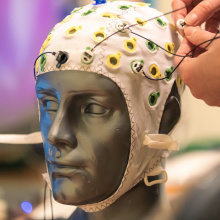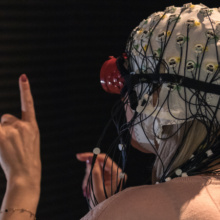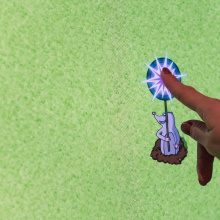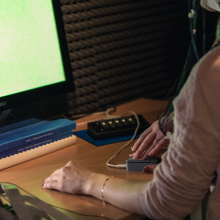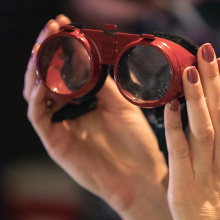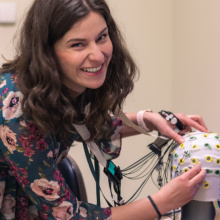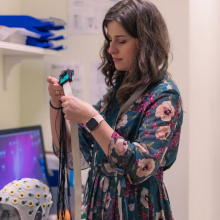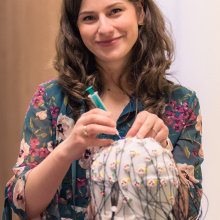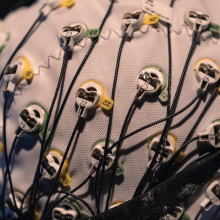She was supposed to become a behavioural therapist for children with developmental difficulties. However, she devoted herself to experimental psychology. Dr Aleksandra Mańkowska from the Department of Neuropsychology at the WNS Institute of Psychology studies processes related to the orientation of visual attention in horizontal and vertical space, and her training in prismatic adaptation is a chance for a long-term improvement in the quality of people's lives struggling with mood swings as a result of depression, bipolar disorder, mania or other mental disorders.
Elżbieta Michalak-Witkowska: - You are interested in processes related to the orientation of visual attention. Among other things, you study how visual perception affects our mood and well-being, that is, how the ability to recognize and differentiate visual stimuli that are in a person's field of vision translates into their emotions. You went into experimental psychology, completely changing the course of your career. Tell us how that came about.
Dr Aleksandra Mańkowska from the Department of Neuropsychology, WNS UG. Photo by Alan Stocki/UG.
Dr Aleksandra Mańkowska: - I did not plan to work as an academic in my life, although from the beginning I dreamed of helping others. At one point I went to a seminar with professor Michał Harciarek - already working as a behavioural therapist. At that time I read a lot about sick people and the methods of help that were being developed. By the end of my studies, I was already thinking about research work differently and I felt that I wanted to deal professionally with experimental neuropsychology, and more specifically with aspects of it that could be developed and through which I could help many different people. When I started to read scientific articles, I became deeply absorbed in issues related to the allocation of attention in space, and by following a thread I came across prismatic adaptation. This method seemed to me, above all, innovative and completely different from what I had known before - I came up with a slightly crazy idea, which I have been developing ever since.
- What is prismatic adaptation?
It is a method of rehabilitation used so far mainly for patients after strokes of the right cerebral hemisphere with the so-called side skipping syndrome. Such patients become unaware of the existence of objects that are located in the left field (for example, they can only eat half of their dinner, or draw a clock with all the hours located on the right side). Prism adaptation is based on using the phenomenon of short-term neuroplasticity of our nervous system. The idea is to widen the patient's field of vision with the help of appropriate exercises and to maintain this effect permanently.
- In training, you use special self-made goggles that move the image 10° up, down, right or left. What is the training about, how do you carry it out and how long does it take?
The training takes about 15-20 minutes. During the tests, which are carried out in the Neuropsychology Department of the University of Gdańsk, I put goggles over the patient's eyes, which, as you have already mentioned, shift the image by 10° depending on the direction in which we want to perform this adaptation. The patient's brain has to adapt to these shifting conditions. For this to happen, the patient performs simple pointing movements. The best are those that require pointing with the finger at a specific object. For example, we have a task displayed on the computer to hit the targets that the moles are holding. But it could be something else - for my Master's thesis, I used a simple indicator - a black straw, which patients with goggles on their eyes hit with their finger. These were healthy people who also adopted to this shift in this way.
- Which patients do you currently work with?
Although the rehabilitative effects of adaptation on attention deficits in stroke patients are well documented, we still know relatively little about the brain mechanisms of adaptation. To be able to verify exactly how it affects neuronal networks, studies are first conducted on neurologically healthy individuals. What I am particularly interested in is the relationship between visual attention and visual perception and reception of emotions. This is the aspect I focus on in my research. If I were to study people after brain injuries, who are a very heterogeneous group (the dynamics of their recovery vary depending on the area of damage, on when the damage occurred, on the age of the subjects, and many other factors), it would be difficult for me to verify my hypotheses. Therefore, for the time being, my research involves mainly healthy people, neurologically and psychiatrically of course, because the research concerns the brain. In further stages of the research, we plan to include mainly people with affective disorders, that is, those struggling with depression, bipolar disorder, or mania.
- Would you like to see how this prismatic adaptation could help people with affective disorders to cope with their emotional difficulties? Does how we perceive the space where we direct our gaze really affect our mood or emotional stability? Does regularly looking up make us feel better and looking down make us feel 'down'?
A lot of data suggests that there are indeed links between a negative mood and increased activity of the right hemisphere of the brain. The right hemisphere is also the hemisphere likely responsible for the left visual field. Research in this area has a long tradition; for example, in experiments using chimeric faces (composed of two halves, one of which is sad and the other happy), most people base their judgement on the left half of the face. In addition, people show better accuracy in recognising facial expressions if they are in the left visual field. Very interestingly, the right hemisphere, according to the valency hypothesis, is responsible for experiencing negative emotions. At the same time, there is data suggesting that the right hemisphere has a stronger representation of the so-called dorsal stream of visual attention, which is responsible for receiving information from the lower visual field. In contrast, the ventral stream, which collects information from the upper visual field, is more strongly represented in the left hemisphere. Hence my crazy idea to use this method to modify the activity of the attentional networks and thus try to influence the perception of emotionally charged images.
- Do I understand correctly that by looking up more often, over the horizon, we are less likely to experience negative emotional states, such as sadness or depression?
It has not been known for a long time that what is good, such as that associated with enlightenment, divinity, goodness and heaven, or with a fleeting sense of a great mood, is associated with the mountain, i.e. it refers to the mountain. In the paintings that are made, the films, the poetic works, you can easily find this relationship - positive emotions tend to be associated with the upper half of space. On the other hand, if we look at the opposite side, not only what is at the bottom is associated with evil, but it is also often associated with sadness, with experiencing negative emotional states, fear, a sense of loneliness, depression. This view has been visible in our culture for many years. However, it has not been previously adapted in such an applied way as I am trying to do, because research on visual attention has mainly focused on the horizontal dimension, that is right-left.
- You mentioned that so far we know very little about the regularities of orientation in the vertical dimension. So your research can be considered groundbreaking.
In fact, only my research, which I am undertaking together with prof. Michal Harciorek and our friends at the University of Florida, including prof. Kenneth M. Heilman has shown that the tendency to direct attention higher firstly increases with age - which is also consistent with the fact that the older we are, the more spiritual we are and the more positive emotional states we can experience. This observation is also in line with worldwide research, which shows that seniors generally have a greater tendency to recall positive events from their lives, the opposite of young people. Besides, we have shown just this link between the severity of depressive symptoms in a healthy population and the tendency to direct attention downwards.
- So the training you are proposing could be applicable to both post-stroke people and those experiencing emotional difficulties?
Yes. In patients who are unable to perceive the left side of space, for example, prismatic adaptation training would have their brain learn to perceive the left side again. Conversely, in people who experience any emotional difficulties, it could be that the training done with these goggles would excite neuronal networks that are less active and responsible for producing neurotransmitters that give a feeling of positive mood. The goals seem quite different, but the neuronal basis of both problems seems quite similar.
- What result are you aiming for? Are you going to create a space where patients can find help or more to launch goggles and an app with the help of which patients can do the exercises themselves?
For now, my focus is on research. I am trying to verify how mood and the ability to perceive emotions change in healthy people, i.e. people who do not experience mood swings towards depression or clinically diagnosed mania. This is based on data that have been obtained using adaptation on the horizontal dimension. However, only adaptation on the vertical dimension will have a much more direct effect on the neuronal networks of interest to me.
Everything else is a wave of the future, but I want to pursue my dream from the very beginning of my PhD - to translate the findings in the field of experimental neuropsychology straight into neurological and psychiatric clinics and rehabilitation wards.
- Let's stay in the future - assuming that everything goes according to your plan and the research confirms your assumptions, how long will the therapy have an effect on patients?
The data so far suggest that it is long-lasting. Across the world, studies unanimously confirm that improvements in attentional function in stroke patients are long-lasting. The effects lasted for another two to three weeks, and after stopping the training for another two years. So this is a very promising method.
However, I emphasise that my project concerns neurologically healthy people. In these people, I study short-term adaptation, the effect of which is ephemeral and lasts up to a maximum of 8 hours. People who come to me take part in the procedure three times - each time with different lenses that shift the image up, down or are smooth. Before and after the adaptation I perform an EEG test, which shows me whether the electrical activity of the brain changes under the influence of the adaptation. After adaptation, subjects rate a series of images and I compare their ratings across all image shifting conditions. Regular training for rehabilitation can lead to a permanent reorganisation of the neuronal networks involved during adaptation, and thus a permanent change in perception.
The power of our brain is very great indeed - it does not need much time to adapt.
- Finally, who can take part in your research and what should they expect?
The project is called 'Effects of changes in the orientation of visual attention on the vertical dimension using a prismatic adaptation procedure on visual emotion perception: a study using EEG', which I coordinate, is currently in the experimental phase. I am looking for neurologically and psychiatrically healthy people, up to about 40 years old, who can come to our department three times and devote about three hours of their time each time. For the participants, in addition to the pleasant atmosphere and the chance to learn more about themselves, I have prepared gift vouchers.
During the whole examination, patients wear an EEG cap on their heads. It is worth mentioning that it is a completely non-invasive examination which measures the electrical activity of the cerebral cortex, thanks to which, live, with a very good temporal resolution, we can determine whether the neuronal networks, which are important from the point of view of my research, have undergone the expected excitation while looking at the pictures presented on the screen.
So far, I have already examined more than 40 participants and I am trying to gradually build up the database. However, I will inform you about the renewed recruitment on the fanpage of the Department of Neuropsychology UG.

